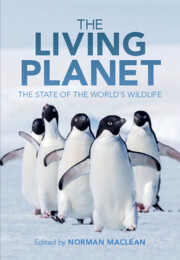Book contents
- The Living Planet
- The Living Planet
- Copyright page
- Contents
- Contributors
- Preface
- Acknowledgements
- One Introduction and the Evolution of Life on Earth
- Two Flowering Plants
- Three Bryophytes and Pteridophytes: Spore-Bearing Land Plants
- Four Terrestrial Mammals
- Five Marine Mammals: Exploited for Millennia, But Still Holding On
- Six How Birds Reveal the Scale of the Biodiversity Crisis
- Seven Reptiles
- Eight Amphibians
- Nine Freshwater Fishes: Threatened Species and Threatened Waters on a Global Scale
- Ten The Amazing Yet Threatened World of Marine Fishes
- Eleven Insects
- Twelve Marine Invertebrates
- Thirteen Non-Insect Terrestrial Arthropods
- Fourteen Terrestrial Invertebrates Other Than Arthropods and Molluscs
- Fifteen Non-Marine Molluscs
- Sixteen An Account of the Diversity and Conservation of Fungi and Their Close Relatives
- Seventeen Simple Life Forms
- Eighteen Assessing Species Conservation Status: The IUCN Red List and Green Status of Species
- Nineteen Problems with the World’s Ecosystems: The Future and Attempts to Mitigate Decline
- Twenty Conservation Methods and Successes
- Twenty One What Does the Future Hold for Our Planet and its Wildlife?
- Species Index
- Subject Index
- References
Sixteen - An Account of the Diversity and Conservation of Fungi and Their Close Relatives
Published online by Cambridge University Press: 13 April 2023
- The Living Planet
- The Living Planet
- Copyright page
- Contents
- Contributors
- Preface
- Acknowledgements
- One Introduction and the Evolution of Life on Earth
- Two Flowering Plants
- Three Bryophytes and Pteridophytes: Spore-Bearing Land Plants
- Four Terrestrial Mammals
- Five Marine Mammals: Exploited for Millennia, But Still Holding On
- Six How Birds Reveal the Scale of the Biodiversity Crisis
- Seven Reptiles
- Eight Amphibians
- Nine Freshwater Fishes: Threatened Species and Threatened Waters on a Global Scale
- Ten The Amazing Yet Threatened World of Marine Fishes
- Eleven Insects
- Twelve Marine Invertebrates
- Thirteen Non-Insect Terrestrial Arthropods
- Fourteen Terrestrial Invertebrates Other Than Arthropods and Molluscs
- Fifteen Non-Marine Molluscs
- Sixteen An Account of the Diversity and Conservation of Fungi and Their Close Relatives
- Seventeen Simple Life Forms
- Eighteen Assessing Species Conservation Status: The IUCN Red List and Green Status of Species
- Nineteen Problems with the World’s Ecosystems: The Future and Attempts to Mitigate Decline
- Twenty Conservation Methods and Successes
- Twenty One What Does the Future Hold for Our Planet and its Wildlife?
- Species Index
- Subject Index
- References
Summary
Neither animals nor plants, the organisms traditionally treated as fungi are distributed across three kingdoms: Fungi, Chromista and Protista. These organisms are critical for society both through direct impacts on human health and the economy and through their intimate involvement in most essential environmental processes. Yet, less than 5% of the estimated 2–4 million species of true fungi have been described, data on species abundances and distributions are fragmentary at best, even for lichens, mushrooms and other macrofungi, and information on their life history and ecology remains woefully incomplete. Fungi are not immune to the stressors that threaten animals and plants, these include habitat loss, overharvesting and climate change. However, the paucity of data on the diversity, distribution and population status of most fungal species has severely limited efforts to assess the extinction risk of fungi. This dearth of data, coupled with perceptions by the conservation community that fungi are not amenable to conservation assessments due to their biology has hindered the development of fungal conservation. This perception is changing, and progress in assessing the conservation status of fungi has been made over the past 5 years, but much work remains. The July 2022 update of the IUCN Red List of Threatened Species includes only 597 of the nearly 150,000 described species of fungi, and these are restricted to only two of the 12 phyla of fungi, Ascomycota and Basidiomycota.
- Type
- Chapter
- Information
- The Living PlanetThe State of the World's Wildlife, pp. 311 - 326Publisher: Cambridge University PressPrint publication year: 2023

